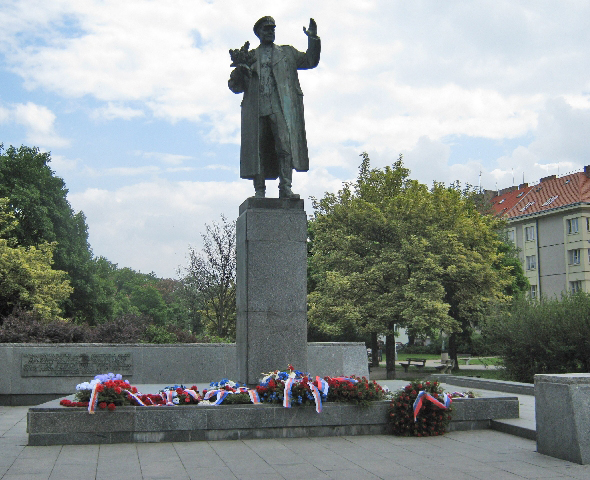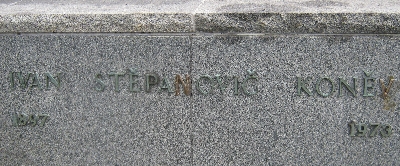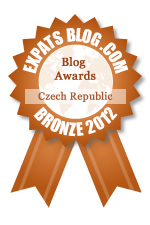Today is a public holiday here in the Czech Republic, as it is in several other European countries. The public holiday marks the ending of World War Two, sixty-seven years ago, on 8th May 1945.
I took the photograph on the left today. It is of a statue that stands in Námestí Interbrigády, a large square on one side of Jugoslávských partyzánu, the main thoroughfare leading from our nearest Metro station at Dejvická, to Podbaba where we live. And the person it portrays is Marshall Ivan Stepanovich Konev of the Soviet Red Army, who led the troops that liberated Prague from Nazi occupation, finally entering the city early on 9th May 1945, just a few hours after the unconditional surrender of all Nazi troops across Europe, had come into force.
As I wrote in an earlier post on this same topic two years ago, this statue is a rare sight today, anywhere in the Czech Republic or Slovakia, as it features a leading figure of the Soviet Army which, during nearly forty-two years of communism, was regarded as an army of occupation by the people of Czechoslovakia. Nearly all public monuments featuring or seeking to celebrate, ‘Soviet friendship and brotherhood’ have, since the Velvet Revolution of 1989, been quietly removed. But, because it commemorates an event that took place before the communist coup in 1948, it remains standing.
As you can see, a large number of floral tributes have been placed at the foot of the statue in recent days. Some are official, such as the ones from the Czech Military and from the Defence Office of the Czech President. Others are simple bunches of flowers, left by private individuals. Although there is a considerable dislike of Russia and Russians amongst the Czech people today, (see some of the comments on my previous post), there is a recognition that it was the Soviet Army that was responsible for liberating Prague and two thirds of what is now the Czech Republic, early in May 1945.
However, I was intrigued by one large floral tribute pictured here, whose ribbons have an inscription written in a language using the Cyrillic alphabet, presumably Russian. If anyone can tell me what it says or which organisation might be responsible for it, I would love to know.
And I was also intrigued by this inscription on the low wall behind the statue, which refers to the country as the Czechoslovak Socialist Republic, the name used only during the years of communist rule. Whereas elsewhere in the Czech Republic, specific communist logos and references have been removed from war memorials such as in Tábor, here communist nomenclature remains.
Whilst the liberation of the country from Nazi occupation is still marked each year here in the Czech Republic, what has changed since the Velvet Revolution, is the attitude of Czech people towards Germany and the German people. Most Czechs are now freely able to distinguish between Nazi Fascist ideology as exemplified by Hitler’s Third Reich, and present-day democratic Germany, still very much aware of it’s relatively recent past history.
Therefore these days, Germany is the Czech Republic’s biggest trading partner. Germans also travel here in considerable numbers to enjoy the delights of what this country has to offer and in doing so, make a major contribution to the Czech Republic’s tourist income.
On the other hand, although the part played by Russia and the Soviet Red Army to liberate the country from Nazi occupation is still acknowledged each year, those who liberated, in turn became an army of occupation. And although all Russian troops had left Czech soil by June 1991, there remains a strong feeling that Russia still wants to control its former republics and satellite states using its economic power, particularly with regard to the supply and distribution of natural gas.







How interesting, Ricky. I got used to passing the statue every time I went into the city centre, but didn’t know the background. It’s good to have a gap in my knowledge filled like this.
Thank you Perpetua – My own understanding of recent European history has been much improved since living here. And I’m always intrigued to see what has been preserved & what has been corrected or got rid of from the Communist era.
Hi Ricky,
My Russian is not perfect (it’s lousy actually) and there are some letters that are impossible to see, but the word Russia is pretty easy to recognise and the word before it seems to be honour. As for the organisation, it is not visible in the picture (if it is there at the end of the ribbon at all).
The hatred for the Russians came in 1968 when they invaded. The hatred is not for Communism as such. As you know, many people (especially intellectuals) thought Communism would be better than capitalism. And there was genuine joy at the end of the Nazi occupation. And they pulled their troops out after the war.
There are some hard feelings about the Americans not liberating Prague (as you have probably noticed Pilsen has large celebrations of the American liberation every year) – the Prague Uprising (after they heard the Americans had liberated Pilsen,, they thought help would arrive) was put down brutally, people were dragged out of their homes and used as human shields in front of the armoured personnel carriers. Those who were involved and hid were found and killed, left where they lay. But as you know that was all because of Yalta. They were sold out by the West. That is why they all wanted to join NATO as soon as possible.
My guess is the statue remained there, because on the morning of the 9th of May there was still fighting in Dejvice. Local people tend to have better memories than politicians. There is also a memorial to the parachutists who killed Heydrich out there (Praha 6, Technická, Dejvice, it is here on this webpage http://www.vets.estranky.cz/clanky/vpm-hlavni-mesto-praha/Vojenska-pietni-mista-v-Praze-6.html) – with a quote from Thomas Jefferson (The tree of liberty must be refreshed from time to time with the blood of patriots and tyrants. … God forbid we should ever be twenty years without such a rebellion; what country can preserve its liberties if their rulers are not warned from time to time that their people preserve the spirit of resistance? Let them take arms)
The war is a complicated topic here (an American quote on a statue a few hundred metres from a statue celebrating the Soviet general with both referring to WWII is a case in point). How Czechs remember history is how they define themselves politically (often who sat in an office with whom or sat in jail with whom – it is not an ideological divide actually).
I have to get back to work.
Have a great day!
Sean
Hi Sean,
Thanks for interpretation of the Cyrillic script on the ribbon and confirming that it is Russian.
I was aware that the hatred of Russia mainly post-dates the crushing of the Prague Spring in August 1968 and that in 1945, the Soviet Red Army were seen as liberators & were welcomed as such. Hence the large vote for the Communists in the 1946 election. And I’ve previously written about the celebrations that now take place in Plzen & elsewhere in Western Bohemia in early May each year, celebrating the liberation of that part of the country by the US Third Army under General Patton. See my http://rickyyates.com/correcting-history/?trashed=1&ids=7337
I’m sure you’re right about the knowledge of local people & that there was still fighting going on in Dejvice & in Bubenec on 9th May 1945. And yes – WW2 is a complicated topic here, hence this post!
Interesting. Thanks 🙂
Most likely the text says: Posol’stvo Rossii = Russian Embassy. But the rest of the text is not visible, so impossible to tell more.
Hi Johanna – I’m sure you’re right, especially as the Russian Embassy is not that far away. Many thanks for the translation/explanation.
It is worth noting that before 1989, the Liberation Day was not celebrated on 8th May, but only a day later, on 9th (as it is still today in Russia and some post-Soviet republics). That is because Soviet Union (and consequently, its satellites) did not recognise the first German capitulation, signed in Reims on 7th May 1945, effective 8th. It was signed without any leading Soviet figure present and Stalin therefore demanded that another capitulation be signed a day later in Berlin, effective 9th. Therefore, from the Russian point of view, the war in Europe ended that day, although the German army had already ceased to fight 24 hour earlier. Sorry if you already mentioned this in your previous post (-:
Thank you for your blogs!!
Hi Martin! Yes – I have mentioned the change of date for marking Liberation Day in the Czech Republic in two previous posts.
You can read about it in my post from January 2010 entitled ‘Correcting History’ http://rickyyates.com/correcting-history/ where I also explain about the complete denial by the communist regime that the whole of Western Bohemia was liberated by the Americans, not the Soviet Red Army. There I mention that the Nazi capitulation signed at Reims came into effect late in the evening of 8th May 1945 & therefore it was after midnight in Moscow! But you are quite correct in saying that there was another ‘signing’ on 9th May in Berlin, organised by the Soviets.
In my post from October 2011 about Tábor http://rickyyates.com/tabor/ , there are two photographs of the war memorial there, clearly showing how the date has been changed from 9th May to the 8th May, along with the removal of the hammer & sickle emblem.
Both words in Cyrillic are in the genitive case: … of the Embassy of Russia.
The Czech text says that Konev was a “double” recipient of the title “Hero of the USSR” and a recipient of the title “Hero of the Czechoslovak Socialist Republic”. So no update is necessary.
Thank you bibax – both for confirming exactly what is on the ribbons in Russian and for clarifying the text regarding Konev. I wasn’t necessarily suggesting that the text about Konev should be updated. I’m just always interested in observing what gets removed, changed or left unaltered from the Communist era.